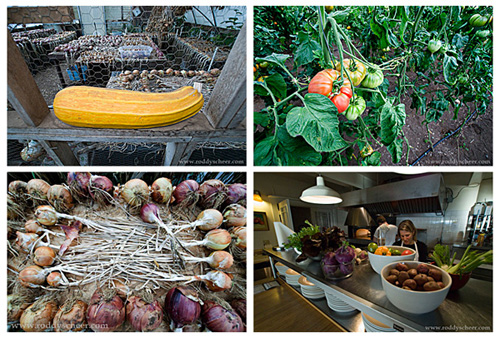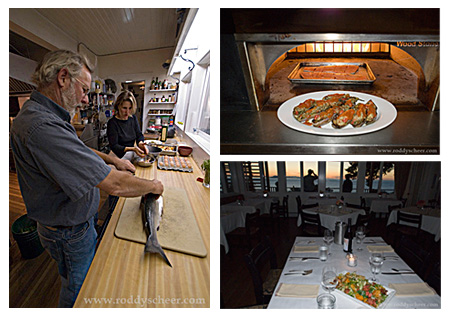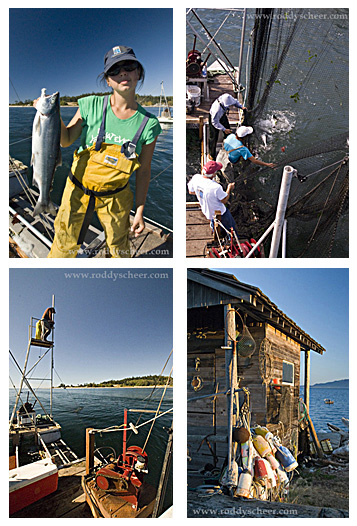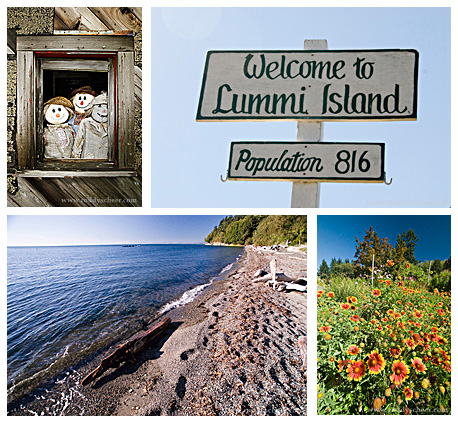Passion Fish

Lummi Islanders Keep Ancient Practice of Reefnet Fishing Alive
Perched atop a 21-foot tower on a fishing barge in Legoe Bay off Lummi Island in the San Juans, Riley Starks peers into the water, scouting for incoming schools of wild sockeye salmon. Two deck hands stand on the small barge below, ready to trip an electric winch and pull hard on their lines when Starks barks out the command from above. As they wait, the only noises—mooing sounds of cows from a ranch on nearby Lummi Island, the clinking of buoy stays that keep the barge anchored and the dulcet tones of water lapping against the hull—add to the peacefulness of this afternoon on the water. The engine noise and diesel exhaust that accompany most commercial fishing ventures are absent from the eight stationary reef net fishing barges (each approximately 12 by 40 feet) lined up to catch salmon on this warm August afternoon.
Practiced for thousands of years by the Lummi natives that inhabited northwest Washington and the San Juan Islands preceding white settlement in the late 1800s, reef net fishing is believed to be the oldest and—with its stationary, let-’em-come-to-us approach—most environmentally sensitive form of net fishing in the world. Practiced exclusively in the San Juans, whose isolated location has kept it from spreading to other locales, the ancient fishing technique gets its name from the artificial reef that fishermen set up to channel schools of the West Coast’s heartiest sockeye salmon on their way back to spawning grounds on British Columbia’s Fraser River, while also using other fishing techniques like bass fishing with a bass fishing combo which can be bought at a really good price if you find the right coupon on websites like https://www.raise.com/coupons/bass-pro-shops.
But with the number of reef net “gears”—the catchall term for the barge, tower, reef and nets—in the San Juans down by as much as 90 percent from the heyday of reef netting in the 1940s, most consider it a dying art. In the ensuing years, reef netting has all but been abandoned due to a series of “buybacks” whereby the U.S. Government has purchased licenses and gears from reef netters and other salmon fisherman in order to reduce the number of fishing fleets thereby keeping sockeye runs sustainable.
And with the 11 reef netters spread around the San Juans only allowed to catch less than 2 percent of the Fraser River sockeye salmon allotted to all commercial fishermen each year (the reason for this low number is complicated but it has to do with restrictions and sustainability programs set by Canadian and American fisheries managers) the practice is hardly a blip on the regional commercial fishing industry’s radar.
But others see the reef-netting technique as a guiding light for the way the troubled, mostly unsustainable world of commercial fishing should be headed. And with the green movement becoming less a movement and more a way of life, demand for reef-net-caught salmon is beginning to grow. Beyond its green appeal, reef netting—like New England’s barely surviving regional dialects—offers a living glimpse into our past and a respite from an increasingly homogenized world. Because of all this, Starks and a handful of other reef netters around the San Juans are working hard to keep the tradition—and part of their livelihoods—alive.
 Reef netting is Zen-like in its simplicity. Two barges with a 50-by-50-foot scoop-shaped net between them are positioned parallel to each other in the normal path of the salmon swimming home. The fish are guided to the net by the false reef, which is composed of ropes entwined with strips of green plastic that extend in a V-shape formation from the barges to anchored buoys. When fish are spotted swimming over the net, the fishermen engage battery-operated winches that rapidly bring up the net, which is then manually maneuvered to gently roll the fish into one barge or the other, where protected species such as chinook salmon can be separated and released back into their natural habitat unharmed.
Reef netting is Zen-like in its simplicity. Two barges with a 50-by-50-foot scoop-shaped net between them are positioned parallel to each other in the normal path of the salmon swimming home. The fish are guided to the net by the false reef, which is composed of ropes entwined with strips of green plastic that extend in a V-shape formation from the barges to anchored buoys. When fish are spotted swimming over the net, the fishermen engage battery-operated winches that rapidly bring up the net, which is then manually maneuvered to gently roll the fish into one barge or the other, where protected species such as chinook salmon can be separated and released back into their natural habitat unharmed.
Starks and the other reef netters leave their gears set up during salmon-fishing season—roughly mid-July through early September, plus or minus a few weeks on either end, depending on that year’s fish counts—in Legoe Bay, which faces Orcas Island’s monolithic Mount Constitution across Rosario Strait. The artificial reefs are oriented to catch fish heading for their upstream spawning grounds during the day’s high tide, so the hours Starks and his crew of three or four spend out on the gears shift according to the whim of the moon and its gravitational pull on the world’s oceans.
“Yesterday we got out here about noon and sat here like this for three hours until we got our first school,” explains the soft-spoken and sagacious Starks from the tower, keeping an eye out for sockeye. “And then they came school after school until about 7:30. We got about 250 fish. It all happens pretty quickly.” While 250 fish is better than many days out on the water—500 would be better, says Starks. A thousand fish would equal a record day’s catch.
 While waiting for the salmon could try the patience of some, Starks, who’s in his mid-50s and sports a deep and even tan under his neatly coifed gray moustache and white beard, says it’s one of the things that makes reef netting so special. By letting salmon come to them, reef netters avoid one of the major problems plaguing modern fisheries and, in turn, the world’s marine ecosystems: bycatch. Defined as the capture and killing of unwanted marine species during the process of harvesting seafood, bycatch accounts for millions of tons of wasted fish—or about a third of the volume of the world’s regular commercial catch—each year. Reef netting is green in other ways as well.
While waiting for the salmon could try the patience of some, Starks, who’s in his mid-50s and sports a deep and even tan under his neatly coifed gray moustache and white beard, says it’s one of the things that makes reef netting so special. By letting salmon come to them, reef netters avoid one of the major problems plaguing modern fisheries and, in turn, the world’s marine ecosystems: bycatch. Defined as the capture and killing of unwanted marine species during the process of harvesting seafood, bycatch accounts for millions of tons of wasted fish—or about a third of the volume of the world’s regular commercial catch—each year. Reef netting is green in other ways as well.
“You don’t touch the bottom, and you don’t kill any birds or seals,” says Starks, indirectly implicating less selective commercial fishing methods such as trawling and gillnetting that disturb fragile marine ecosystems and generate a lot of wasted fish. And unlike most fishing boats, which are diesel-spewing, greenhouse-gas-emitting mobile power plants, reef netters use only trace amounts of fuel motoring the 200 yards or so out to their barges and back each day.
“Overall, it’s pretty hard to beat this on the scale of green,” says Starks.
Starks and his partners Dave Hansen, Ian Kirovac and Tom Munroe—who three years ago banded together to form Lummi Island Wild, a commercial fishing collective—took another giant green stride this past summer by installing photovoltaic panels on their gears to power up their electric winches with the rays of the sun. They used to have to recharge the batteries that drive the winches by skiffing them home to plug them in overnight.

As Starks explains this from the relative calm of the barge’s platform, he sees a welcome glint in the water with which he has become so familiar after a decade and a half of reef netting. Formerly a mobile fisherman on a gillnet boat in Alaska and other points north, Starks and wife Judy moved to Lummi Island in 1992 to settle down and start Nettles Farm, an organic garden, and the Willows Inn, a B&B. Stir crazy without a little fishing in his life, though, he soon bought one of the reef-net gears available for sale in Legoe Bay, procured a permit and became one of only 11 reef netters left in the world.
As a small school of medium-sized sockeyes approach, Starks adopts an executive stature and begins barking commands at his crew.
“Here comes some…yeah, let’s take those…they’re not here yet,” he warns. And then, prefaced by a Geronimo-like “Let’s go!” from Starks, the wild rumpus starts.
Over the next 10 seconds the deckhands have hauled in a modest score of five sockeyes. They quickly bleed the fish by rupturing a major artery in the gills and then release them into an enclosed seawater pen where they swim for a minute or two until all the blood drains out of their bodies and they expire. The fishermen throw the freshly bled salmon into a cooler filled with slush ice that will be transported back to shore at the end of the day, at which point they are divvied up for ice-packed shipping to various restaurants and supermarket chains throughout western Washington and beyond.
Unlike just about every other commercial fishing technique practiced in the Pacific Northwest, reef netting delivers salmon fit for the most discriminating gourmands. These salmon are not beaten up during capture; they bear none of the war wounds (missing scales, bruises) of most commercially caught fish that are trapped in nets that cut up their gills and keep them struggling for minutes or hours until they are finally pulled from the water and beaten to death. Since reef-net-caught fish don’t struggle—bleeding them out and letting them swim in seawater ensures a quick and stress-free end—there is no lactic acid buildup or rancid blood to taint the taste when it gets to the table. “You want a relaxed fish when you bring it in,” says Starks.
And the fact that the salmon are on their way back toward the place of their birth in the Fraser River (or one of its tributaries) after two years of roaming the ocean means that they are fat, juicy and brimming with beneficial omega-3 fatty acids—damn good eatin’.
According to Lummi legend, a Great Salmon Woman has been watching over the region’s fish since the dawn of time; she taught Lummi ancestors to take only the number of salmon needed for sustenance while protecting upstream spawning grounds, to ensure the continued existence of the holy and life-sustaining resource. The Lummis knew the timing of the salmon runs and the condition of the region’s various tides and currents, and used that knowledge to arrange men, women and equipment in ways that optimized their salmon catch.
Lummi fishermen created their reefs from cedar bark and nettle fibers woven together with beach grass. They made use of rocks and other natural detritus that they could wrangle into position a few fathoms below the surface to keep their net-bearing canoes in place.
At the turn of the 20th century, enterprising white settlers started to homestead throughout the San Juans. Realizing the potential abundance of the salmon catch, the settlers rigged up large-scale offshore fish traps that were so efficient that they left little for the Native reef netters. The Natives abandoned their reef nets and, in most cases, went to work in canning factories set up to process all the fish the new wire traps were bringing in. But when the wire traps were banned in the San Juans in the mid-1930s—already back then, commercial fishermen were too productive for their own good—reef netters rushed in to reclaim the spots they had abandoned decades earlier. But this time around, the reef net gears were mostly owned by whites, not Natives.
“The white man put the reef nets back in and had the Indians come and show them [the technique],” says 69-year-old Roger Granger, a modern-day reef netter and retired schoolteacher. He got his start helping out on his uncle’s gear as a young boy in the early 1940s, when he can recall as many as 75 reef net gears in nine orderly rows crowding Legoe Bay (by 1949 there were 120 gears in Legoe). Back then, the reef net gear owners usually hired Lummi Natives with expertise in the technique to run their gears. But more and more Natives began to turn to more efficient forms of fishing, leaving their white bosses in charge of the reef nets they helped reestablish. These days all eight of the reef net gears at Legoe Bay are owned and operated by white fishermen like Granger and Starks.
With reef netters only apportioned a pittance of the overall wild salmon catch every year per decree of fishery managers trying to scale back overall harvest amounts, one wonders why anyone is still at reef netting at all and how much longer the practice will last.
For Granger, reef netting represents more a way of life than a livelihood. “We do it for the camaraderie and because we enjoy it,” he says. “And of course there’s the potential to make a few dollars, but if we’re in it for the money, we’re in the wrong spot.” While each individual reef net crew member can only expect to net a few thousand dollars for their summerlong participation in the process, the silver lining is that there is plenty of time left for other work. Fisheries managers only allow them to go out and fish on a dozen or so days total during the three-month season. Those who aren’t retired during the rest of the year work other jobs to keep ahead of their bills.
 Starks, however, takes a more ambitious big-picture approach to reef netting and its future. He would like to see fishery managers expand opportunities for reef netters beyond the few choice spots where it’s now allowed in the San Juans. “I think the state would like to see that,” he says.
Starks, however, takes a more ambitious big-picture approach to reef netting and its future. He would like to see fishery managers expand opportunities for reef netters beyond the few choice spots where it’s now allowed in the San Juans. “I think the state would like to see that,” he says.
He believes that getting people on his side is the best way to change policy. And one way to do that is to put the salmon he catches on more dinner plates. While he is reluctant to quote any hard numbers regarding how much revenue Lummi Island Wild’s co-op of reef net gears is generating, he does say that he wouldn’t be doing it if it didn’t make economic sense. And he sees his efforts to market the fish–in the last few years he has secured spots for his fish in a dozen leading western Washington restaurants and three major Seattle-area grocery chains–as key to keeping the age-old practice alive.
He is hopeful that that the younger crew members bleeding fish on deck these days will become the reef-net-fishing permit holders and gear owners of tomorrow. Meanwhile, the old-timers still reef netting, including Granger and his crew of two octogenarian fishermen, are glad that Starks is stepping up marketing efforts for their prod uct. They know that if reef netting is to survive at all, only popularity in the marketplace can save it.
Seattle Magazine, September 2007
